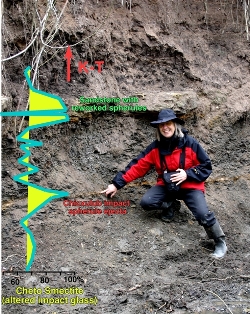 The enduringly popular theory that the Chicxulub crater holds the clue to the demise of the dinosaurs, along with around 65% of all species 65 million years ago, is challenged in a paper to be published in the Journal of the Geological Society this week (27 April) writes Sarah Day
The enduringly popular theory that the Chicxulub crater holds the clue to the demise of the dinosaurs, along with around 65% of all species 65 million years ago, is challenged in a paper to be published in the Journal of the Geological Society this week (27 April) writes Sarah Day
Geoscientist Online Monday 27 April 2009
The crater, discovered in 1978 in northern Yucutan and measuring about 180km in diameter, records a massive extra-terrestrial impact. When spherules from the impact were found just below the Cretaceous-Tertiary (K-T) boundary, it was quickly identified as the ‘smoking gun’ responsible for the mass extinction event that took place approximately 65 million years ago. It was this event which saw the demise of dinosaurs, along with countless other plant and animal species.
However, a number of scientists have since disagreed with this interpretation. The newest research, led by Dr Gerta Keller at the University of Princeton and Thierry Adatte, University of Lausanne, Switzerland, uses evidence from Mexico to suggest that the Chicxulub impact predates the K-T boundary by as many as 300,000 years. "From El Penon and other localities in Mexico we know that between 4 and 9 metres of sediments were deposited at about 2-3 centimetres per thousand years after the impact. The mass extinction level can be seen in the sediments above this interval" says Keller.
Advocates of the Chicxulub impact theory suggest that the impact crater and the mass extinction event only appear far apart in the sedimentary record because of earthquake or tsunami disturbance that resulted from the impact of the asteroid.
‘The problem with the tsunami interpretation’ says Dr Keller, ‘is that this sandstone complex was not deposited over hours or days by a tsunami; deposition occurred over a very long time period’.
The study found that the sediments separating the two events were characteristic of normal sedimentation, with burrows formed by creatures colonising the ocean floor, erosion and transportation of sediments, and no evidence of structural disturbance.
As well as this, they found evidence that the Chicxulub impact had nothing like the dramatic impact on species diversity that has been suggested. At one site at El Peon, the researchers found 52 species present in sediments below the impact spherule layer, and counted all 52 still present in layers above the spherules. In contrast, at a site at La Sierrita which records the K-T boundary, 31 out of 44 species disappeared from the fossil record.
"We found that not a single species went extinct as a result of the Chicxulub impact…these are astonishing results that have been confirmed by more studies in Texas" says Keller.
This conclusion should not come as too great a surprise, however. None of the other five great mass extinctions is associated with an impact, and no other large craters are known to have caused a significant extinction event.
In place of Chicxulub, Keller suggests that the massive volcanic eruptions at the Deccan Traps in India may be responsible for the extinction, releasing massive amounts of dust and gases that could have blocked out sunlight and brought about significant climatic changes. The fact that Chicxulub seems to have had no effect on biota, despite its size, indicates that even large asteroid impacts may not inevitably bring death, destruction and extinction to huge swathes of the biota.
Keller is hopeful that this new evidence will lend more weight to a theory she has been arguing for over 20 years. Despite an increasingly strong body of evidence against it, the Chicxulub impact theory continues to be adhered to by many.
"The impact-kill theory is beautiful in its simplicity’ she admits. In contrast, ‘the ground truth, the data that supports the impact and at the same time refutes the theory, is messy and complicated by normal geological processes".
If Keller is right, then there could be much more to learn from Chicxulub than what it can tell us about the K-T mass extinction, not least the powerful influence of scientific consensus. As one reviewer wrote in response to an earlier paper by Keller, "I don’t believe it, because how can so many be so wrong for so long?"
Flat earthers, phlogiston theorists, geocentrists and creationists take note.
Ref: Journal of the Geological Society, Vol. 166, 2009, pp. 1-19.